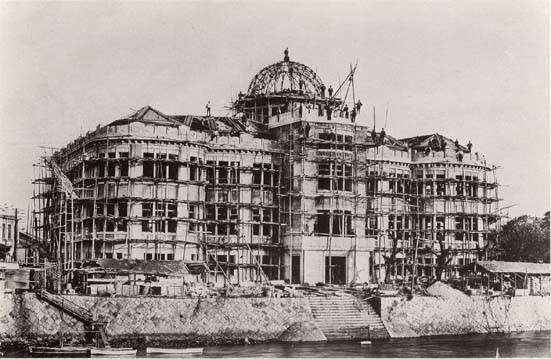
By the latter part of the Meiji period (early 20th century), traditional industry and modern industry related to military supply had become developed to a great extent in Hiroshima. In particular, with the breakout of the Russo-Japanese War in 1904, the Hiroshima City and its surrounding areas prospered from a healthy economy due to a great population increase in the city and the local mass production of military goods. In conjunction with this economic development, demands arose for the establishment of core facilities that would aid in the development of products that could successfully compete in the highly competitive Japanese market, in the improvement of product quality and in the expansion of sales routes for modern industries which up to that point had not been very developed.
In response to the requests of its citizens, the Hiroshima City council proposed in a meeting in 1905 to purchase the land of the old Shinshu Sect (group of Buddhist) mission hall site in Ote-machi 1-chome for the construction of a commercial exhibition hall. The city then established a temporary survey commission which launched the process of investigating how to establish and fund the proposed hall, but the plan itself was postponed for a lack of funds. In October 1909, the city learned that the Hiroshima prefectural government was also involved in the planning of an exhibition hall. The city gave up on the idea of constructing the building with city funds and submitted an opinion paper to the prefectural governor expressing the hope for construction of a hall to take place in timely fashion. In August 1910, the city council passed an opinion paper requesting that construction take place on city property if the prefecture were going to use prefectural funds for construction, a move which ultimately led to the strengthening of the development of the construction project.
Meanwhile, in October 1903, for the first time a proposal whereby the establishment of the Commercial Exhibition Hall would take place with prefectural money was made in a Hiroshima Prefecture provisional assembly. In November of 1907 and 1908, opinion papers were submitted and both times the assembly unanimously adopted the proposals for the establishment of the exhibition hall. In 1910, then-governor Tadasu Munakata budgeted for the construction plan for the 1911 fiscal year. He decided that construction of the exhibition hall was to take place over a four-year period at a cost of 110,404 yen. The work was begun on April 1, 1911. In March of the next year, 1912, the succeeding governor, Junkuro Nakamura, carried on the construction work. At the prefectural assembly, however, local representatives from area towns and villages harshly opposed putting a priority on work in the city. It was such a difficult struggle it is said that two stud horses and two bulls had to be promised each county before an agreement was reached.
In February 1913, Sukeyuki Terada, who was transferred to the position of Hiroshima Prefecture's governor from the governor's post in Miyagi Prefecture, vigorously promoted the construction of the building. On December 27 of the same year, bidding for the right to construct the structure took place. No one succeeded in winning the bid, so the launching of the construction project was postponed until January the following year.

Dome under construction (Courtesy of Hiroshima Municipal Archives)
In the beginning of construction, the projects of the city and the prefecture were in competition with each other. Because the prefecture had designed a better version, the burden- sharing of the costs between the city and the prefecture and the issue of contributing land area for the project underwent deliberation.
To obtain a sufficient amount of land area, in January 1913 the civil section of the General Affairs Division of the Hiroshima City Hall embarked on land reclamation of a total area of 2,310 square meters, comprising the banks of the Motoyasu River lying between the Aioi Bridge and the Motoyasu Bridge, including a levee. Nevertheless, because that area was insufficient, the city purchased the old clan rice storehouse in Saiku-machi. Moreover, in July 1913 the city carried out demolition work in the area to change privately held land in the vicinity into land for the project to make up for insufficient space. A total of 3,214.2 square meters of city land in Sarugaku-cho, 17-banchi, was prepared for the project and donated to the prefecture, which estimated the cost to be three yen per 3.306 square meters. In addition, one section of the area was the result of a land exchange that took place between the Agricultural and Commerce Ministry and the city of Hiroshima in July 1912.
The city prepared the land for the project in this way, and construction on the Hiroshima Prefecture Commercial Exhibition Hall commenced with the prefecture taking responsibility. In July 1909, another building, the Hiroshima Products Exhibition Hall, was opened as a corporate organization in the commercial hall in Hiroshima's Ote-machi, 1-chome. By the end of 1913, however, the company had gone under, leading to an increase in demand for the establishment of public organizations of the kind.